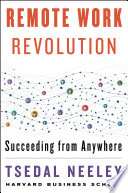

The book emphasizes the significant shift from traditional office environments to remote work setups, accelerated by the COVID-19 pandemic. It discusses how organizations had to adapt quickly to remote work, highlighting the benefits of flexibility, increased productivity, and the ability to tap into a global talent pool. The authors argue that this shift is not just a temporary response to a crisis but a fundamental change in how work is structured. They present evidence that remote work can lead to better work-life balance for employees, which in turn can enhance job satisfaction and retention. The key takeaway is that organizations must embrace this change and develop strategies to manage remote teams effectively.
Continue readingA strong remote work culture is crucial for the success of distributed teams. The book outlines how leaders can foster a sense of belonging and community among remote employees. It emphasizes the importance of communication, transparency, and inclusivity in creating a thriving remote work environment. The authors provide practical tips for cultivating a positive culture, such as regular check-ins, virtual team-building activities, and recognition programs. They argue that a healthy remote work culture not only enhances employee morale but also drives performance and innovation, making it a vital component of remote work strategies.
Continue readingCommunication is a cornerstone of successful remote work. The book discusses the challenges that remote teams face regarding communication and collaboration and offers solutions to overcome these hurdles. It highlights the need for clear communication channels and guidelines to ensure that team members are aligned and informed. The authors stress the importance of utilizing various tools and technologies to facilitate communication, such as video conferencing, messaging apps, and project management software. They also encourage leaders to promote open communication and feedback, which can help build trust and strengthen team dynamics.
Continue readingThe book delves into the intricacies of managing employee performance in a remote setting. It challenges traditional performance management practices and advocates for more flexible and outcome-oriented approaches. The authors suggest setting clear goals and expectations, focusing on results rather than hours worked, and using regular feedback loops to assess performance. They emphasize the importance of trusting employees to manage their time and deliverables, which can lead to increased autonomy and motivation. By adopting these practices, organizations can create a performance-driven culture that thrives in a remote work environment.
Continue readingOne of the significant advantages of remote work is the potential for improved work-life balance. The book discusses how remote work can help employees better manage their personal and professional lives, reducing stress and burnout. It encourages organizations to support their employees' well-being by promoting healthy work habits, such as setting boundaries between work and personal time, encouraging regular breaks, and providing mental health resources. The authors argue that prioritizing employee well-being is not only beneficial for individuals but also enhances overall organizational performance.
Continue readingThe role of technology in facilitating remote work is a central theme in the book. The authors explore various tools and platforms that enable remote collaboration, communication, and project management. They discuss the importance of choosing the right technology stack to support remote teams and how organizations can leverage technology to enhance productivity and efficiency. The book also addresses the challenges of technology adoption and the need for ongoing training and support to ensure that employees can effectively use the tools at their disposal.
Continue readingFinally, the book looks ahead to the future of work, positing that remote work is here to stay. The authors argue that organizations must be proactive in adapting to this new landscape by rethinking their policies, practices, and workplace designs. They encourage leaders to embrace flexibility and innovation, recognizing that the future of work will likely involve a hybrid model that combines remote and in-office work. The book concludes with a call to action for organizations to invest in their remote work strategies to remain competitive and attract top talent.
Continue reading